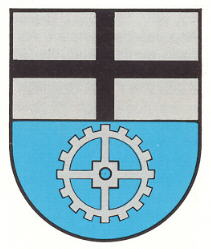Limburgerhof: Difference between revisions
Knorrepoes (talk | contribs) m (Text replacement - "{{de}}" to "") |
Knorrepoes (talk | contribs) m (Text replacement - "{| class="wikitable"↵|+Official blazon↵|-↵|'''German'''↵| ↵|-↵|'''English''' ↵| {{blazon wanted}}↵|}" to "{| class="wikitable" |+Official blazon |- |'''German''' | blazon wanted |- |'''English''' | blazon wanted |}") |
||
| Line 13: | Line 13: | ||
|- | |- | ||
|'''German''' | |'''German''' | ||
| | | blazon wanted | ||
|- | |- | ||
|'''English''' | |'''English''' | ||
| | | blazon wanted | ||
|} | |} | ||
Revision as of 07:22, 6 April 2023
LIMBURGERHOF
State : Rheinland-Pfalz
District (Kreis) : Rhein-Pfalz Kreis
Additions : 1930 (parts of) Mutterstadt, Neuhofen, Rheingonheim, Schifferstadt
| German | blazon wanted |
| English | blazon wanted |
Origin/meaning
The arms were granted in 1932 for the newly created municipality. As no historical arms or seals existed the arms were newly devised. The upper part shows the cross for the Benedictine Abbey Limburg. The abbey gave the municipality its name and played an important role in the local history.
The will wheel symbolises the Rehhütte water mill, which was first mentioned in 1241, in the oldest settled part of the municipality. The colours of the lower part are derived from the colours of the State of Speyer, and of the upper part derived from the Pfalz. The area historically belonged either to the Pfalz or the State of Speyer.
Literature: Stadler, 1964-1971, 8 volumes.
